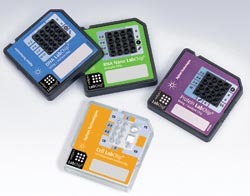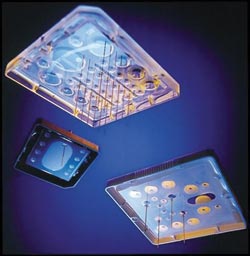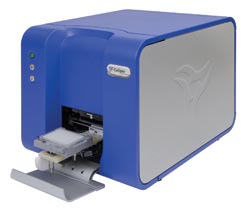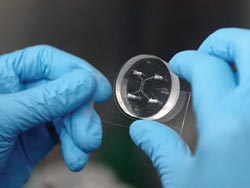David L. Shenkenberg, Features Editor
According to the Jan. 15, 2009, Genetic Engineering and Biotechnology News, the market for microfluidic technology will climb toward $1.9 billion over the next three years.

Shown are LabChips made by Caliper for the Agilent 2100 Bioanalyzer.
Microfluidic chips are small rectangular pieces of glass, hard plastic or poly(dimethylsiloxane), a rubbery material used to make contact lenses. The tiny chips contain very small channels through which fluid flows. They save lab space, increase productivity and can enable studies that heretofore were impossible.

Caliper’s own systems use special chips that sip up liquid from 96- or 384-well plates.
The Agilent 2100 Bioanalyzer and Bio-Rad Experion are microfluidic systems that have been selling for a decade. They are economically priced and designed for customers who need to manually load only 12 samples at a time. Both use chips from Caliper Life Sciences of Hopkinton, Mass.
Caliper also sells its own machines that can perform automatic sample loading from 96- or 384-well plates. According to Nate Cosper, director of marketing for Caliper, these systems are marketed to pharmaceutical companies that need high-throughput instruments. “Nineteen of the top 20 pharmaceutical companies use LabChip technologies … the last remaining holdout has an instrument in the purchasing department,” he said.
Microfluidic tasks
The company has two product lines, the LabChip GX and the LabChip EZ Reader. The LabChip GX series enables separations and analysis of nucleic acids and proteins, and the EZ Reader models do enzymatic assays, particularly for mechanism-of-action studies. “You can detect the same well over and over again with a lot less reagent than you would otherwise,” Cosper said. The LabChip products use lasers and, more recently, LEDs for excitation and standard detectors.

Caliper’s LabChips fit into user-friendly boxed systems, such as this LabChip GX.
“Microfluidics, when it was in its infancy, was seen as a great way to miniaturize,” Cosper said, but now we’re asking, “What are the applications that this can enable you to do that you otherwise couldn’t have done?”
Another company that has been innovating in microfluidic technology is Fluidigm Corp., based in South San Francisco. Its BioMark system is a real-time quantitative polymerase chain reaction machine. Illumination is accomplished with a xenon arc lamp and detection with a standard CCD camera. It also comes with various excitation and emission filters and is compatible with up to five reporter dyes per run. But the real selling point of the machine is that, when used with 96 × 96 dynamic arrays, it can do 9216 reactions in a single three-hour run, the same amount of time as for a single 384-well plate while using just 1/200th the amount of reagents.

Researchers from MIT have created a microfluidic chip that enables monitoring cell growth in 3-D.
Stanford researchers, including Drs. Robert Cho and Maximilian Diehn of the medical school, used the BioMark and TaqMan probes to study why cancer stem cells are more resistant to radiation treatment than other types of cancer cells. The researchers studied cells from humans and mice and found that the cancer stem cells churned out antioxidants that protected them from radiation. These results were published in the Feb. 4, 2009, issue of Nature.
On Nov. 4, 2008, the company released the EP1 system, which can analyze more than 200,000 genotypes per day. The company says that it has call rates better than 99 percent and 99.75 percent or greater accuracy.
It’s no wonder then that the company’s sales growth increased in the second half of 2008, even though 2008 was a difficult recession year for most companies. Fluidigm considered an initial public offering, or IPO, in 2008, but decided against it.
Fluidigm was co-founded by Stephen Quake, a Stanford professor and a Howard Hughes investigator. In an article in the Nov. 6, 2007, issue of Science, he said of the state of microfluidic systems today: “It’s like a computer or car: Most people cannot build one or fix one, but they can learn how to use them.”
In the research lab
Roger Kamm and colleagues at MIT have developed a microfluidic chip that enables observation of three-dimensional cell growth and migration, which is important because cells naturally grow in three dimensions. Typical microfluidic chips allow researchers to observe growth only on a flat two-dimensional surface, or they lack the ability to enable researchers to perform a controlled experiment. The device is so small that it is imprinted on one square inch of plastic, yet it contains a three-dimensional collagen scaffold in which cells can grow and be observed under controlled physical and chemical conditions.
In the Oct. 31, 2008, issue of Lab on a Chip, the researchers in the Kamm lab used the device to monitor the spread of cancer cells and the growth of blood vessels. Tumors grow blood vessels before they spread and therefore become difficult to treat. The microfluidic device could be used in pharmaceutical laboratories or directly on patients in hospitals to evaluate the efficacy of cancer drugs. Kamm’s group has studied growth patterns of liver cells, stem cells and neurons and also has investigated the pressure buildup that causes glaucoma.
At the Institute for Systems Biology in Seattle and at the University of British Columbia in Vancouver, researchers have used a poly(dimethylsiloxane) microfluidic system that enables 256 simultaneous time-lapse live-cell imaging experiments. They used 12 devices for more than 3000 experiments and generated almost 50,000 images.
In these experiments, they worked with 11 mutants of brewer’s yeast. The GFP-expressing yeast cells were captured in 2048 microfluidic traps and imaged with a Leica microscope modified with a custom LED light source and a Hamamatsu cooled CCD. Using this system, they were able to observe several phenotypic changes in the yeast that researchers say have never been observed before.